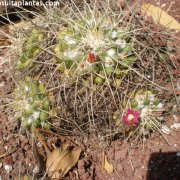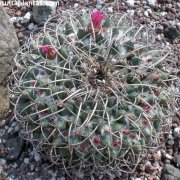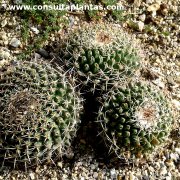Care of the cactus Mammillaria magnimamma or Mexican Pincushion |
|
The genus Mammillaria, family Cactaceae, includes more than 350 species of cactus native to Mexico mostly. Some species are: Mammillaria magnimamma, Mammillaria longimamma, Mammillaria lenta, Mammillaria laui, Mammillaria karwinskiana, Mammillaria hahniana, Mammillaria haageana, Mammillaria geminispina, Mammillaria discolor, Mammillaria crinita, Mammillaria compressa, Mammillaria carmenae, Mammillaria candida, Mammillaria bombycina, Mammillaria backebergiana, Mammillaria marksiana, Mammillaria parkinsonii, Mammillaria pringlei, Mammillaria spinosissima, Mammillaria vetula, Mammillaria petterssonii, Mammillaria magnifica, Mammillaria matudae, Mammillaria uncinata. Common name: Mexican Pincushion. Scientific synonyms: Neomammillaria magnimamma, Mammillaria macracantha. This species is native to Central Mexico. They are cacti with a globose body and an intense green color that form colonies and reach 30 cm (11.8") in height. The tubers are large, quadrangular and have white wool in the armpits. They have 0-4 radial spines and 3-6 central spines. The flowers form a crown on the top of the cactus and can be pink, cream or yellow. They bloom in spring. The fruits are 2.5 cm (0.98") long and red. Mexican Pincushion is used in pots, in mini cactus gardens, in greenhouses, in rockeries and in gardens of succulents and cacti. Mammillaria magnimamma grows in full sun or light shade exposure and in hot, dry climates. In winter it's better for the temperature to be above 3 ºC (37.4 ºF). The soil can be a mixture of 1/3 of blond peat, 1/3 of coarse siliceous sand and 1/3 of vegetable substrate. Water moderately in spring and summer waiting for the substrate to dry completely. Starting in the fall, reduce watering and do not water in winter. Fertilize monthly in spring and summer with mineral fertilizer for cacti and succulents. Mexican Pincushion does not need pruning. The main enemies of Mammillaria magnimamma are excess humidity and attacks by mites and mealybugs. Mammillaria macracantha propagates by separating suckers or by seeds sown at the end of winter in a slightly humid sandy substrate. |
Images of the cactus Mammillaria magnimamma or Mexican Pincushion |
Find plants
Mammillaria magnimamma or Mexican Pincushion | Care and Growing
© 2026 FavThemes







